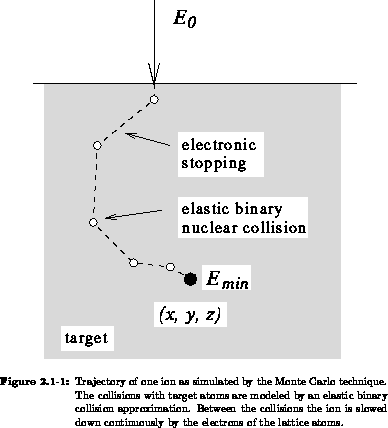2.1.1 Monte Carlo Simulation




Next: 2.1.2 Boltzmann Transport Equation
Up: 2.1 Physically Based Modeling
Previous: 2.1 Physically Based Modeling
All physical effects of ion implantation can be described by the Monte
Carlo technique [Rob63], [Rob74], [Bie80], [Maz84],
[Zie85], [Hob89]. There, the trajectory of an individual ion is
traced on its way through the target until it comes to rest. Each ion starts
at a given position with a known energy  and direction.
Figure 2.1-1 shows schematically the trajectory of one ion. On
its way it collides with other atoms, transfers energy to these atoms and is
slowed down by interaction with the electrons of the lattice atoms. The
energy passed to the other atoms can be high enough to displace these atoms
from their lattice position which may interact with other atoms subsequently.
and direction.
Figure 2.1-1 shows schematically the trajectory of one ion. On
its way it collides with other atoms, transfers energy to these atoms and is
slowed down by interaction with the electrons of the lattice atoms. The
energy passed to the other atoms can be high enough to displace these atoms
from their lattice position which may interact with other atoms subsequently.

The ion is assumed to change direction with each elastic binary nuclear
collision and to move in a straight free flight path between collisions.
Between elastic collisions, the ion loses energy via inelastic electronic
stopping independent of elastic contributions. When the ion's energy drops
below some threshold  (
( ), it stops and the end point of the
trajectory
), it stops and the end point of the
trajectory  is included in a histogram which builds the doping
profile. To achieve statistically relevant results a high number of
trajectories has to be simulated, at least 10,000 for one-dimensional
profiles and more than 100,000 for two-dimensional profiles.
is included in a histogram which builds the doping
profile. To achieve statistically relevant results a high number of
trajectories has to be simulated, at least 10,000 for one-dimensional
profiles and more than 100,000 for two-dimensional profiles.
A typical example of Monte Carlo results is shown in Figure 2.1-2.
Common elements  have been simulated for an implant energy
of
have been simulated for an implant energy
of  . The jagged character of the curves reflects the histogram boxes.
All results have been obtained by the simulation of 10,000 trajectories.
. The jagged character of the curves reflects the histogram boxes.
All results have been obtained by the simulation of 10,000 trajectories.

The drawback of this technique is the large amount of time necessary for the
calculations, although major efforts have succeeded in increasing
computational efficiency [vS89] [Hob89]. Nearly all efficient
programs assume amorphous targets, leading to the neglection of
channeling effects. Monte Carlo programs for crystalline targets
[Lin63], [Rob74], [Hob91], [Kle92] are many times more
computationally expensive.




Next: 2.1.2 Boltzmann Transport Equation
Up: 2.1 Physically Based Modeling
Previous: 2.1 Physically Based Modeling
Martin Stiftinger
Wed Oct 19 13:03:34 MET 1994
 and direction.
Figure 2.1-1 shows schematically the trajectory of one ion. On
its way it collides with other atoms, transfers energy to these atoms and is
slowed down by interaction with the electrons of the lattice atoms. The
energy passed to the other atoms can be high enough to displace these atoms
from their lattice position which may interact with other atoms subsequently.
and direction.
Figure 2.1-1 shows schematically the trajectory of one ion. On
its way it collides with other atoms, transfers energy to these atoms and is
slowed down by interaction with the electrons of the lattice atoms. The
energy passed to the other atoms can be high enough to displace these atoms
from their lattice position which may interact with other atoms subsequently.





 (
( ), it stops and the end point of the
trajectory
), it stops and the end point of the
trajectory  is included in a histogram which builds the doping
profile. To achieve statistically relevant results a high number of
trajectories has to be simulated, at least 10,000 for one-dimensional
profiles and more than 100,000 for two-dimensional profiles.
is included in a histogram which builds the doping
profile. To achieve statistically relevant results a high number of
trajectories has to be simulated, at least 10,000 for one-dimensional
profiles and more than 100,000 for two-dimensional profiles.
 have been simulated for an implant energy
of
have been simulated for an implant energy
of  . The jagged character of the curves reflects the histogram boxes.
All results have been obtained by the simulation of 10,000 trajectories.
. The jagged character of the curves reflects the histogram boxes.
All results have been obtained by the simulation of 10,000 trajectories.
